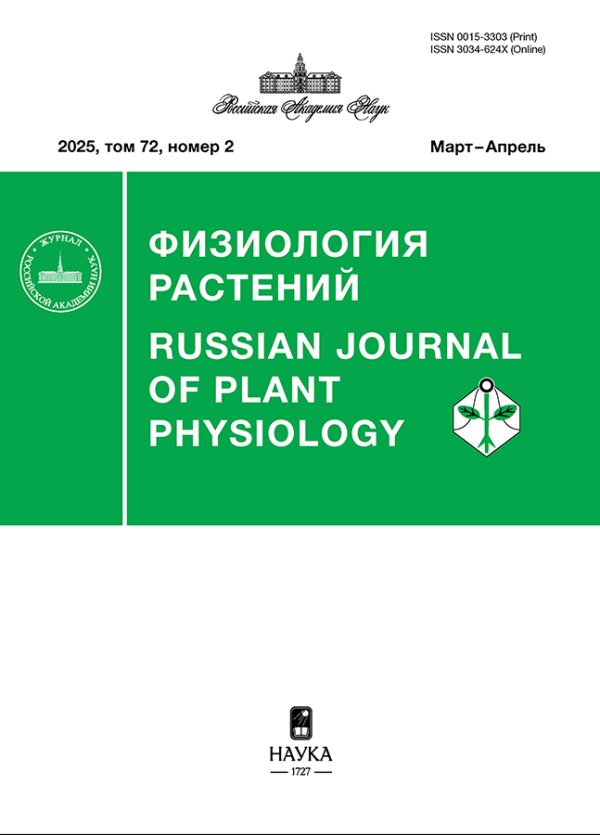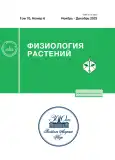Age and Adaptive Changes in the Photosynthetic Apparatus of Leaves in Winter Green Herbaceous Plant Ajuga reptans L. in the Natural Conditions of the Taiga Zone
- Authors: Dymova O.V.1, Zakhozhiy I.G.1, Golovko T.K.1
-
Affiliations:
- Institute of Biology, Komi Science Centre, Ural Branch, Russian Academy of Sciences
- Issue: Vol 70, No 6 (2023)
- Pages: 577-587
- Section: ЭКСПЕРИМЕНТАЛЬНЫЕ СТАТЬИ
- URL: https://journals.rcsi.science/0015-3303/article/view/232765
- DOI: https://doi.org/10.31857/S0015330323600237
- EDN: https://elibrary.ru/WJNZQE
- ID: 232765
Cite item
Full Text
Abstract
The formation and functioning of the photosynthetic apparatus (PSA) is under the general control of the plant organism and constantly changing environmental conditions. The authors studied age-related and adaptive changes in the pigment complex, spectral properties, and the state of photosystem II (PSII) leaves of partial shoots of a summer-winter-green herbaceous perennial Ajuga reptans L. (bugle) in connection with overwintering. Rosette leaves of a new generation appearing in May–June quickly accumulated photosynthetic pigments and formed PSA with a maximal quantum efficiency of PSII (Fv/Fm) and actual quantum yield of PSII (ФPSII). In autumn (September–October), the content of chlorophylls was 10 mg/g dry weight, the value of Fv/Fm was 0.8 rel. units, and the level of ФPSII at PAR 130 µmol quanta/(m2 s) was approximately 0.7 rel. units. Overwintered leaves contained half as much photosynthetic pigments, accumulated a significant amount of anthocyanins, and were characterized by low photochemical activity and a high level of de-epoxidation of pigments of the violaxanthin cycle. With the resumption of active vegetation of plants (May), a partial restoration of the pigment pool and the repair of PSA of overwintered leaves were noted, as evidenced by an increase in the quantum yield PSII. The completion of the leaf life cycle was accompanied by a decrease in ФPSII up to 0.5 rel. units and a sharp increase in the thermal dissipation of absorbed excitation energy (NPQ) to 0.9 rel. units. Seasonal changes of spectral properties of leaves and photochemical reflectance indices generally corresponded to the dynamics content pigments and the efficiency of the use of light in photosynthesis. The results obtained indicate a significant transformation of the structural and functional organization of PSA in the ontogeny of overwintering leaves. The genetically fixed property of winter green plants to preserve leaves is based on the ability of their PSA to restore functional activity after the shock impact of overwintering, which is facilitated by a complex of adaptive and protective mechanisms.
About the authors
O. V. Dymova
Institute of Biology, Komi Science Centre, Ural Branch, Russian Academy of Sciences
Email: dymovao@ib.komisc.ru
Syktyvkar, Russia
I. G. Zakhozhiy
Institute of Biology, Komi Science Centre, Ural Branch, Russian Academy of Sciences
Email: dymovao@ib.komisc.ru
Syktyvkar, Russia
T. K. Golovko
Institute of Biology, Komi Science Centre, Ural Branch, Russian Academy of Sciences
Author for correspondence.
Email: dymovao@ib.komisc.ru
Syktyvkar, Russia
References
- Öquist G., Huner N.P.A. Photosynthesis of overwintering evergreen plants // Annu. Rev. Plant Biology. 2003. V. 54. P. 329. https://doi.org/10.1146/annurev.arplant.54.072402.115741
- Solanki T., Aphalo P.J., Neimane S., Hartikainen S.M., Pieriste M., Shapiguzov A., Porsar-Castell A., Atherton J., Heikilla A., Robson T.M. UV-screening and spring-time recovery of photosynthetic capacity in leaves of Vaccinium vitis-idaea above and below the snow pack // Plant Physiol. Biochem. 2019. V. 134. P. 40. https://doi.org/10.1016/j.plaphy.2018.09.003
- Verhoeven A.S., Adams lii W.W., Demmig-Adams B. The xanthophyll cycle and acclimation of Pinus ponderosa and Malva neglecta to winter stress // Oecologia. 1999. V. 118. P. 277. https://doi.org/10.1007/s004420050728
- Verhoeven A.S., Adams lii W.W., Demmig-Adams B. Two forms of sustained xanthophylls cycle-dependent energy dissipation in overwintering Euonymus kiautschovicus // Plant, Cell Environ. 1998. V. 21. P. 893. https://doi.org/10.1046/j.1365-3040.1998.00338.x
- Logan B.A., Grace S.C., Adams lii W.W., Demmig-Adams B. Seasonal differences in xanthophyll cycle characteristics and antioxidants in Mahonia repens growing in different light environments // Oecologia. 1998. V. 116. P. 9.https://doi.org/10.1007/PL00013823
- Adams lii W.W., Demmig-Adams B., Rosenstiel T.N., Brightwell A.K., Ebbert V. Photosynthesis and photoprotection in overwintering plants // Plant Biology. 2002. V. 4. P. 545.
- Adams W.W., Zarter C.R., Ebbert V., Demmig-Adams B. Photoprotective strategies of overwintering evergreens // Bioscience. 2004. V. 54. P. 41.
- Yatsco Y.N., Dymova O.V., Golovko T.K. Violaxanthin cycle pigment de-epoxidation and termal dissipation of light energy in three boreal species of evergreen conifer plants // Russ. J. Plant Physiol. 2011. V. 58. P. 169.
- Sofronova V.E., Chepalov V.A., Dymova O.V., Golovko T.K. The role of pigment system of an evergreen dwarf shrub Ephedra monosperma in adaptation to the climate of Central Yakutia // Russ. J. Plant Physiol. 2014. V. 61. P. 246. https://doi.org/10.1134/S1021443714010142
- Sofronova V.E., Dymova O.V., Golovko T.K., Chepalov V.A., Petrov K.A. Adaptive changes in pigment complex of Pinus sylvestris needles upon cold acclimation // Russ. J. Plant Physiol. 2016. V. 63. P. 433. https://doi.org/10.1134/S1021443716040142
- Steyn W.J., Wand S.J.E., Holcroft D.M., Jacons G. Anthocyanins in vegetative tissues: a proposed unified function in photoprotection // New Phytologyst. 2002. V. 155. P. 349. https://doi.org/10.1046/j.1469-8137.2002.00482.x
- Hughes N.M., Smith W.K. Seasonal photosynthesis and antocyanin production in ten broadleaf evergreen species// Funct. Plant Biol. 2007. V. 34. P. 1072. https://doi.org/10.1071/FP07205
- Merzlyak M., Gitelson A., Chivkunova O., Solovchenko A., Pogosyan S. Application of reflectance spectroscopy for analysis of higher plant pigments // Russ. J. Plant Physiol. 2003. V. 50. P. 704. https:// doi: 1021-4437/03/5005
- Gitelson A.A., Keydan G.P., Merzlyak M.N. Three-band model for noninvasive estimation of chlorophyll, carotenoids, and anthocyanin contents in higher plant leaves. Geophysical research letters. 2006. V. 33. P. L11402. https://doi.org/10.1029/2006GL026457
- Головко Т.К., Яцко Я.Н., Дымова О.В. Сезонные изменения состояния фотосинтетического аппарата трех бореальных видов хвойных растений в подзоне средней тайги на европейском северо-востоке // Хвойные бореальной зоны. 2013. Т. 30. С. 73.
- Dymova O., Khrystin M., Miszalski Z., Kornas A., Strzalka K., Golovko T. Seasonal variations of leaf chlorophyll-protein complexes in the wintergreen herbaceous plant Ajuga reptans L. // Funct. Plant Biol. 2018. V. 45. P. 519. https://doi.org/10.1071/FP17199
- Дымова О.В., Тетерюк Л.В. Физиологическая и популяционная экология неморальных травянистых растений на Севере. Екатеринбург: Уральское отделение Российской академии наук, 2000. 144 с.
- Атлас Республики Коми по климату и гидрологии / Отв. ред. Таскаев А.И. Москва: Издательский дом “Дрофа”, Изд-во “ДиК”, 1997. 115 с.
- Dymova O.V., Golovko T.K. Light adaptation of photosynthetic apparatus in Ajuga reptans L., a shade-tolerant plant as an example // Russ. J. Plant Physiol. 1998. V. 45. P. 440.
- Lee J., Durst R.W., Wrolsrad R.E. Determination of total monomeric anthocyanin pigment content of fruit juices, beverages, natural colorants, and wines by the pH differential method: collaborative study // Journal of AOAC International. 2005. V. 88. P. 1269.
- Gitelson A., Merzlyak M.N. Spectral reflectance changes associated with autumn senescence of Aesculus hippocastanum L. and Acer platanoides L. leaves. Spectral features and relation to chlorophyll estimation // J. Plant Physiol. 1994. T. 143. P. 286.
- Gamon J.A., Serrano L., Surfus J.S. The photochemical reflectance index: an optical indicator of photosynthetic radiation use efficiency across species, functional types, and nutrient levels // Oecologia. 1997. V. 112. P. 492. https://www.jstor.org/stable/i391072
- Gitelson A.A., Zur Y., Chivkunova O.B., Merzlyak M.N. Assessing carotenoid content in plant leaves with reflectance spectroscopy // Photochemistry and photobiology. 2002. V. 75. P. 272. https://doi.org/10.1562/0031-8655
- Goltsev V.N., Kalaji H.M., Paunov M., Baba W., Horalzek T., Mojski J., Kociel H., Allakverdiev S.I. Variable chlorophyll fluorescence and its use for assessing physiological condition of plant photosynthetic apparatus // Russ. J. Plant Physiol. 2016. V. 63. P. 869. https://doi.org/10.1134/S1021443716050058
- Дымова О.В., Головко Т.К. Морфофизиологические аспекты вегетативного размножения Ajuga reptans L. // Репродуктивная биология растений на европейском Северо-Востоке. Сыктывкар, 1998. С. 72.
- Далькэ И.В., Чадин И.Ф., Малышев Р.В., Захожий И.Г., Тишин Д.В., Харевский А.А., Солод Е.Г., Шайкина М.Н., Попова М.Ю., Полюдченков И.П., Тагунова И.И., Лязев П.А., Беляева А.В. Морозоустойчивость борщевика Сосновского по результатам лабораторных и полевых экспериментов // Российский журнал биологических инвазий. 2019. № 4. С. 12. http:// proborshevik.ru/wp-content/uploads/2019/11/Dalke-i-dr.-RZHBI_4_2019.pdf
- Ottander C., Campbell D., Qquist G. Seasonal changes in photosystem II organization and pigment composition in Pinus sylvestris // Planta. 1995. V. 197. P. 176.
- Martz F., Sutinen M.-L., Derome K., Wingsle G., Julkunen-Tiitto R., Turunen M. Effects of ultraviolet (UV) exclusion on the seasonal concentration of photosynthetic and UV-screening pigments in Scots Pine needles // Global Change Biology. 2007. V. 13. P. 252. https://doi.org/10.1111/j.1365-2486.2006.01275.x
- Rochaix J.D. Regulation and dynamics of the light-harvesting system // Annu. Rev. Plant Biol. 2014. V. 65. P. 287. https://doi.org/10.1146/annurev-arplant-050213-040226
- Junker L.V., Ensminger I. Relationship between leaf optical properties, chlorophyll fluorescence and pigment changes in senescing Acer saccharum leaves // Tree Physiology. 2016. V. 36. P. 694. http://doi:https://doi.org/10.1093/treephys/tpv148
- Merzlyak M.N., Chivkunova O.B., Solovchenko A.E., Naqvi K.R. Light absorption by anthocyanins in juvenile, stressed, and senescing leaves // J. Exp. Botany. 2008. V. 59. P. 3903. https://doi.org/10.1093/jxb/ern230
- Hughes N.M., Burkey K.O., Cavender-Bares J., Smith W.K. Xanthophyll cycle pigment and antioxidant profiles of winter-red (anthocyanic) and winter-green (acyanic) angiosperm evergreen species // J. Exp. Bot. 2012 V. 63. P. 1895. https://doi.org/10.1093/jxb/err362
- Pietrini F., Iannelli M.A., Massacci A. Anthocyanin accumulation in the illuminated surface of maize leaves enhances protection from photo-inhibitory risks at low temperature, without further limitation to photosynthesis // Plant, Cell Environ. 2002. V. 25. P. 1251. https://doi.org/10.1046/j.1365-3040.2002.00917.x
- Manetas Y., Drinia A., Petropoulou Y. High contents of anthocyanins in young leaves are correlated with low pools of xanthophyll cycle components and low risk of photoinhibition // Photosynthetica. 2002. V. 40. P. 349.
- Neill S.O., Gould K.S. Anthocyanins in leaves: light attenuators or antioxidants? // Funct. Plant Biol. 2003. V. 30. P. 865. https://doi.org/10.1071/FP03118
- Hoch W.A., Zeldin E.L., McCown B.H. Physiological significance of anthocyanins during autumnal leaf senescence // Tree physiology. 2001. V. 21. P. 1. https://doi.org/10.1093/treephys/21.1.1
- Feild T.S., Lee D.W., Holbrook N.M. Why leaves turn red in autumn. The role of anthocyanins in senescing leaves of red-osier dogwood // Plant Physiol. 2001. V. 127. P. 566.
- Latowski D., Dymova O., Maslova T., Strzaƚka K. The xanthophyll cycle and its physiological functions // Photosynthetic pigments – chemical structure, biological function and ecology. Syktyvkar: Komi Scientific Centre of the Ural Branch of the Russian Academy of Sciences, 2014. P. 183.
- Gamon J.A., Serrano L., Surfus R. The photochemical reflectance index: an optical indicator of photosynthetic radiation use efficiency across species, functional types, and nutrient levels // Oecologia. 1997. V. 112. P. 492. https://doi.org/10.1007/s004420050337
- Kováč D., Veselovská P., Klem K., Večeřová K., Ač A., Pañuelas J., Urban O. Potential of photochemical reflectance index for indicating photochemistry and light use efficiency in leaves of european beech and Norway Spruce trees // Remote Sensing. 2018. V. 10. P. 1202. https://doi.org/10.3390/rs10081202
Supplementary files














